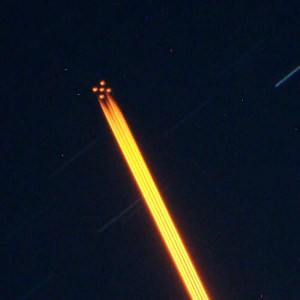Aug 12 2013
“Celestial Pollution” from meteors like this weekend’s Perseid Meteor Shower sprinkle sodium high up in our atmosphere and give astronomers what they need to see the universe in much greater detail.
 Close up of the Gemini South (GeMS) laser which splits into 5 points to create a 'constellation' of guide stars for improved corrections over a larger patch of sky. The points at the end of the laser "columns" are where the laser light excites sodium atoms about 90 kilometers overhead and produces laser guide stars used for adaptive optics. The visibility of the laser "columns" beneath the laser guide star "constellation" is due to scattering of the laser's light by dust and moisture in the lower atmosphere. Credit: Gemini Observatory/AURA
Close up of the Gemini South (GeMS) laser which splits into 5 points to create a 'constellation' of guide stars for improved corrections over a larger patch of sky. The points at the end of the laser "columns" are where the laser light excites sodium atoms about 90 kilometers overhead and produces laser guide stars used for adaptive optics. The visibility of the laser "columns" beneath the laser guide star "constellation" is due to scattering of the laser's light by dust and moisture in the lower atmosphere. Credit: Gemini Observatory/AURA
This weekend, as millions of people gaze up at the stars and wait for Perseid meteors to streak across the sky, one would hardly think that these awe-inspiring “shooting stars” are also a source of atmospheric pollution.
However, meteors, like those from this month’s Perseid meteor shower, burn up high in the Earth’s atmosphere leaving behind gases. “It’s a form of natural pollution,” says Gemini Observatory’s Chad Trujillo who heads up the facility’s state-of-the-art Adaptive Optics (AO) program.
This "pollution" doesn't actually pose a threat to humanity, (it's been around for eons and seems to have had no adverse effect), but it's a real boon to astronomers..
“One of the gases left behind by meteors is sodium, which collects in a layer about 60 miles (90 kilometers) above the Earth,” says Trujillo (see animation). “The reason astronomers are so fond of this particular pollution layer is because we can make it glow by using a sodium laser to excite this sodium and produce temporary, artificial stars wherever we like. Believe it or not,” jokes Trujillo, “there aren’t enough stars in the sky for astronomers!”
Astronomers use these artificial stars, called laser-guide-stars, for AO systems such as the latest technology at the Gemini South telescope in Chile. AO allows scientists to see the universe with unprecedented clarity.
The Perseid meteors are byproducts of Comet 109/Swift-Tuttle, which leaves a trail of dust and ice behind when it passes by Earth’s orbit. Each year, however, the Earth passes through the comet’s dust- and ice-filled orbit. As it plows through that “debris,” it’s small particles burn up in our atmosphere.
“Perhaps one person’s celestial ‘pollution’ is another’s ‘natural resource,’” said Maria Womack, an astronomy program officer at the US National Science Foundation (NSF). “It's this sodium layer, provided courtesy of meteors like the Perseids, that astronomers use to get the clearest views and understand the universe better.”
To celebrate this “happy marriage” of AO laser-guide-star technology and natural meteor remains in Earth’s atmosphere, Gemini Observatory is releasing a spectacular set of images illustrating laser guide stars, including its newest technology which is part of its GeMS Adaptive Optics system (GeMS stands for Gemini Multi-conjugate adaptive optics System and is featured in a recent press release at: www.gemini.edu/node/12028). The GeMS system uses five separate laser beams to create a “constellation” of laser guide stars, (see top figure) which allows for significantly better corrections than previous generations of AO systems.
“The next generation of large ground-based telescopes will require advanced AO systems like GeMS to work at their full-potential,” Trujillo explains, “because as telescopes get bigger they must look through a wider column of air. The wider the column of air, the more turbulence in the air will distort the observed light. Using laser guide stars gives us a reference so we can correct for that turbulence and see things with amazing clarity from the ground.”
In addition to Gemini South, a laser guide star system is used at the Gemini North telescope on Mauna Kea in Hawai‘i (see images) and many major ground-based observatories worldwide.
Enjoy this year’s Perseid Meteor shower which peaks on the night of August 11-12; astronomers will!